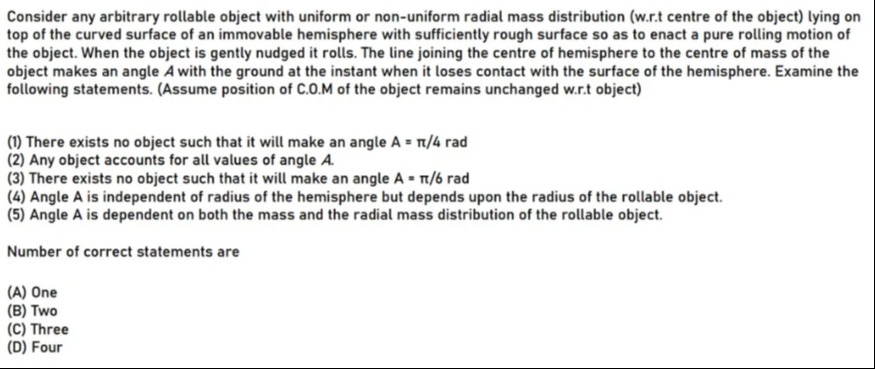Question
Question: Consider any arbitrary rollable object with uniform or non-uniform radial mass distribution (w.r.t c...
Consider any arbitrary rollable object with uniform or non-uniform radial mass distribution (w.r.t centre of the object) lying on top of the curved surface of an immovable hemisphere with sufficiently rough surface so as to enact a pure rolling motion of the object. When the object is gently nudged it rolls. The line joining the centre of hemisphere to the centre of mass of the object makes an angle A with the ground at the instant when it loses contact with the surface of the hemisphere. Examine the following statements. (Assume position of C.O.M of the object remains unchanged w.r.t object)
(1) There exists no object such that it will make an angle A=π/4 rad (2) Any object accounts for all values of angle A. (3) There exists no object such that it will make an angle A=π/6 rad (4) Angle A is independent of radius of the hemisphere but depends upon the radius of the rollable object. (5) Angle A is dependent on both the mass and the radial mass distribution of the rollable object.
Number of correct statements are

One
Two
Three
Four
Two
Solution
Let R be the radius of the hemisphere and r be the radius of the rollable object (assuming it's a sphere). Let M be the mass and ICM be the moment of inertia about the center of mass (COM). For a sphere with COM at its geometric center, rolling without slipping on a hemisphere, the angle θ from the vertical at which it loses contact is given by cosθ=3+k2, where k=ICM/(Mr2). The angle with the ground is A=π/2−θ, so sinA=cosθ=3+k2.
For any physically realistic sphere, 0<k≤1. Thus, 3<3+k≤4, and 41≤3+k1<31. So 21≤sinA<32.
(1) A=π/4, sinA=1/2≈0.707. Since 0.707>2/3≈0.667, sinA=1/2 is not in the range [21,32). So there exists no such object (among spheres with COM at center) that loses contact at A=π/4. This statement is true.
(2) The angle A is restricted to the range [arcsin(1/2),arcsin(2/3)), so it cannot take all values. Statement is false.
(3) A=π/6, sinA=1/2. Since 1/2 is in the range [21,32), A=π/6 is a possible angle (e.g., for a thin spherical shell where k=1). Statement is false.
(4) The formula sinA=3+k2 does not depend on the radius of the hemisphere R. It depends on k=ICM/(Mr2), which depends on the radius r and the mass distribution. Statement is true.
(5) The angle A depends on k=ICM/(Mr2), which characterizes the radial mass distribution. However, it does not depend on the total mass M explicitly (as k is independent of M). Statement is false.
Assuming the problem refers to a sphere with COM at the center, there are 2 correct statements.
